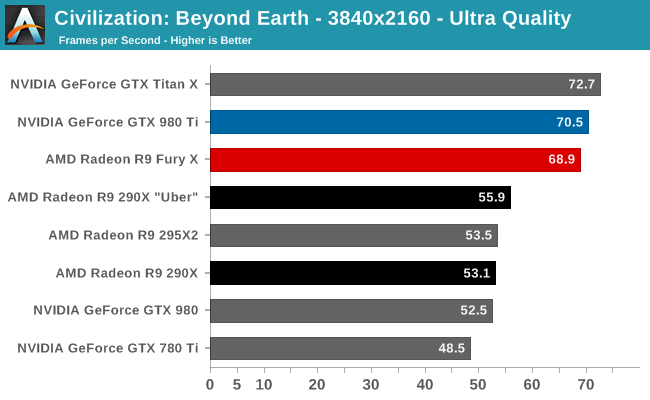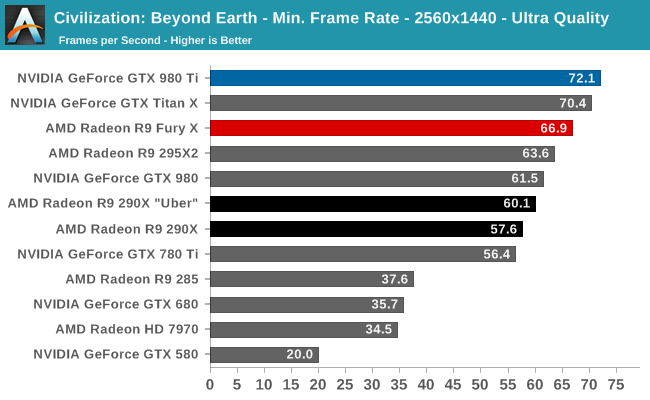The AMD Radeon R9 Fury X Review: Aiming For the Top
by Ryan Smith on July 2, 2015 11:15 AM ESTCivilization: Beyond Earth
Shifting gears from action to strategy, we have Civilization: Beyond Earth, the latest in the Civilization series of strategy games. Civilization is not quite as GPU-demanding as some of our action games, but at Ultra quality it can still pose a challenge for even high-end video cards. Meanwhile as the first Mantle-enabled strategy title Civilization gives us an interesting look into low-level API performance on larger scale games, along with a look at developer Firaxis’s interesting use of split frame rendering with Mantle to reduce latency rather than improving framerates.


Unlike Battlefield 4 where we needed to switch back to DirectX for performance reasons on the R9 Fury X, AMD’s latest card still holds up rather well on Mantle here, probably due to the fact that Civilization is a newer game. Though not drawn in this chart, what we find is that AMD loses a frame or two per second for running Mantle, but in return they see far, far better minimums (more on that later).
Overall then the R9 Fury X looks pretty good at 4K. Even at Ultra quality it can deliver a better than 60fps average and is within 2% of the GTX 980 Ti. On the other hand AMD struggles a bit more at 1440p, where the absolute framerate is still rather high, but relative to the GTX 980 Ti it’s now an 11% performance gap. This being a Mantle game, the fact that AMD does fall behind is a bit surprising, as at a high level they should be enjoying the CPU benefits of the low-level API. We’ll revisit 1440p performance a bit later on, but this is going to be a recurring quirk for AMD, and a detriment for 1440p 144Hz monitor owners.


The bigger advantage of Mantle is really the minimum framerates, and here the R9 Fury X soars. At 4K the R9 Fury X delivers a minimum framerate of 50.5fps, some 20% better than the GTX 980 Ti. Both cards do well enough here, but it goes without saying that this is a very distinct difference, and one that is well in AMD’s favor. The only downside for AMD here is that they can’t keep this advantage at 1440p, where they go back to trailing the GTX 980 Ti in minimum framerates by 7%.
On that note I do have one concern here with AMD’s support plans for Mantle. Mainly I’m worried that as well as the R9 Fury X does here, there’s a risk Mantle may stop working in the future. The GCN 1.2 based R9 285 can’t use the Mantle path at all (it crashes), and the R9 Fury X is not all that different in architecture.










458 Comments
View All Comments
just4U - Saturday, July 4, 2015 - link
I thought it was great as well.. It had a lot more meat to it then I was expecting. Ryan might have been late to the party but he's getting more feedback than most other sites on his review so that shows that it was highly anticipated.B3an - Saturday, July 4, 2015 - link
I don't understand why the Fury X doesn't perform better... It's specs are considerably better than a 290X/390X and it's memory bandwidth is far higher than any other card out there... yet it still can't beat the 980 Ti and should also be faster than it already is compared to the 290X. It just doesn't make sense.just4U - Saturday, July 4, 2015 - link
Early drivers and perhaps the change over into a new form of memory tech has a bit of a tech curve that isn't fully realized yet.Oxford Guy - Saturday, July 4, 2015 - link
Perhaps DX11 is holding it back. As far as I understand it, Maxwell is more optimized for DX11 than AMD's cards are. AMD really should have sponsored a game engine or something so that there would have been a DX12 title available for benchmarkers with this card's launch.dominopourous - Saturday, July 4, 2015 - link
Great stuff. Can we get a benchmarks with these cards overclocked? I'm thinking the 980 Ti and the Titan X will scale much better with overclocking compared to Fury X.Mark_gb - Saturday, July 4, 2015 - link
Great review. With 1 exception.Once again, the 400 AMP number is tossed around as how much power the Fury X can handle. But think about that for one second. Even a EVGA SuperNOVA 1600 G2 Power Supply is extreme overkill for a system with a single Fury X in it, and its +12V rail only provides 133.3 amps.
That 400 AMP number is wrong. Very wrong. It should be 400 watts. Push 400 Amps into a Fury X and it most likely would literally explode. I would not want to be anywhere near that event.
AngelOfTheAbyss - Saturday, July 4, 2015 - link
The operating voltage of the Fury chip is probably around 1V, so 400A sounds correct (1V*400A = 400W).meacupla - Saturday, July 4, 2015 - link
okay, see, it's not 12V * 400A = 4800W. It's 1V (or around 1V) * 400A = 400W4800W would trip most 115VAC circuit breakers, as that would be 41A on 115VAC, before you even start accounting for conversion losses.
bugsy1339 - Saturday, July 4, 2015 - link
Anyone hear about Nvidia lowering thier graphics quality to get a higher frame rate in reviews vs Fury? Reference is semi accurate forum 7/3 (Nvidia reduces IQ to boost performance on 980TI? )sa365 - Sunday, July 5, 2015 - link
I too would like to know more re:bugsy1939 comment.Have Nvidia been caught out with lower IQ levels forced in the driver?